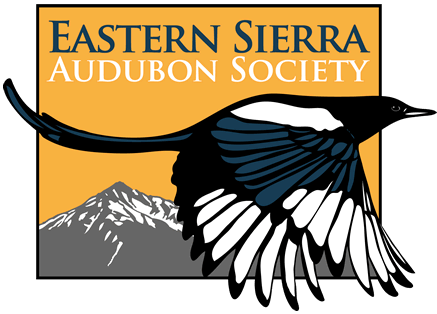Have you noticed that winter is not the same as summer! No, not the cooler temperatures, the lack of leaves or the cold winds, but the birds. Some species of birds visit us only in the winter while others, called permanent residents, are here all year. The obvious permanent residents familiar to most are American Crow, Common Raven, Black-billed Magpie, Starling, Red-winged Blackbird, Great Blue Heron and others, all of which will suffer our winter with us.
As we human permanent residents know, winter can be very harsh in Inyo County. Because important bird food such as insects and fruit becomes scarce, those species who depend on it must migrate south where it is available year around. Of the 13 normally occurring flycatchers, only the Black Phoebe and Say’s Phoebe remain. The rest migrate to Mexico, Central & South America in the company of our swallows, vireos and warblers. The only warbler that normally winters in the county is the Yellow-rumped (Audubon’s) Warbler who, along with other insectivores, has adapted to exploiting food sources such as seeds and berries during the winter months. The Swainson’s Hawk, a partial insectivore, spends our summer breeding and eating crop destroying insects in Inyo County, then migrates to Argentina where it spends its summer eating crop destroying insects too!
This dramatic change from summer to winter avifauna is marked by the early arrival of the Ferruginous Hawk. The earliest record is for 13 Aug. 1989 at Fish Springs, just south of Big Pine, but more typically this rusty buteo with the pointed wings arrives in late September and remains until March. The Sharp-shinned and Cooper’s Hawks, broad-winged accipiters, become more numerous in September. October brings the Merlin and many more Prairie Falcons from the north. November will usher in the Rough-legged Hawk and Bald Eagle. Check for our national emblem at Tinemaha Reservoir and Haiwee Reservoir, two favorite fishing areas. Most of these raptors will remain until March.
Waterfowl are an important part of our winter avifauna. The first Greater White-fronted Geese come through in September. The earliest record is 2 Sep. 1990 at Owens Lake. Snow Geese, Canada Geese and Tundra Swans build up their numbers in November along with a wide variety of ducks such as Northern Shoveler, Canvasback, Ring-necked Duck, Bufflehead, Lesser Scaup, & Common Merganser.
You may have noticed that yards, gardens, and fields began filling with White-crowned Sparrows in September. This race (called Gambel’s) breeds in northwest Canada and Alaska. The mountain race that bred in the Sierra has already departed for Mexico and won’t return until next May. Mixed in with our wintering White-crowns are a few Golden-crowned Sparrows that also summered in the Pacific northwest. They can be more easily seen slightly upslope along the watered canyons.
American Pipits returned from the north in September and will be with us until April. They are common on golf courses, lawns, and along the edges of lakes and ponds. Their call, a high, sharp, “pip-pit” is given repeatedly as they fly overhead.
Many forms of the Dark-eyed Junco will entertain us through winter. The Oregon Junco may have bred in our local mountains, descending to the valley in winter. The Pink-sided and Slate-colored Juncos have come from far to the north and east of us. If you study these juncos closely, you may see many that seem to share marks of each. That’s because they interbreed regularly!
A very special, but erratic, winter visitor is the Bohemian Waxwing. Examine all Cedar Waxwings closely to make sure you aren’t overlooking this rare look-alike. Some years they don’t move this far south, but if they do, you don’t want to be one to miss out. The Bohemian has yellow “V’s” and a white line on the wings and rusty undertail coverts.
Another special winter visitor, who also has a common look-alike, is the Northern Shrike. Check carefully all Loggerhead Shrikes for one that is larger, paler above, has faint barring on the breast, a larger bill, and a white rump. Be careful with the last mark as some of our Loggerheads also have a white rump. In some winters up to 4 or 5 Northern Shrikes are recorded in the county, while none are seen in other winters.
As there are many fewer species in the county during winter, the chances of confusing one species with another are greatly reduced. This is an excellent time to work on and learn to recognize our common birds. Check the birds in your yard and try to join one of the many Audubon field trips with experienced leadership that is anxious to help you solve your bird identification problems.
Tags: blackbird, crow, duck, falcon, flycatcher, hawk, heron, junco, magpie, owl, raven, sparrow, swan, vireo, warbler
